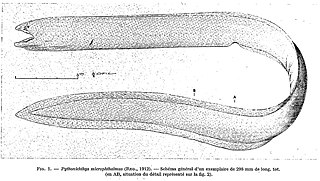
The superorder Elopomorpha contains a variety of types of fishes that range from typical silvery-colored species, such as the tarpons and ladyfishes of the Elopiformes and the bonefishes of the Albuliformes, to the long and slender, smooth-bodied eels of the Anguilliformes. The one characteristic uniting this group of fishes is they all have leptocephalus larvae, which are unique to the Elopomorpha. No other fishes have this type of larvae.

The cusk-eel family, Ophidiidae, is a group of marine bony fishes in the Ophidiiformes order. The scientific name is from the Greek ophis meaning "snake", and refers to their eel-like appearance. True eels diverged from other ray-finned fish during the Jurassic, while cusk-eels are part of the Percomorpha clade, along with tuna, perch, seahorses and others.

The herring smelts or argentines are a family, Argentinidae, of marine smelts. They are similar in appearance to smelts but have much smaller mouths.
Gnathophis is a genus of marine congrid eels.

The Heterenchelyidae or mud eels are a small family of eels native to the Atlantic, Mediterranean, and eastern Pacific.

Eels are ray-finned fish belonging to the order Anguilliformes, which consists of eight suborders, 20 families, 164 genera, and about 1000 species. Eels undergo considerable development from the early larval stage to the eventual adult stage and are usually predators.
Ampheristus is an extinct genus of prehistoric marine ray-finned fish. It was a basal or stem member of the family Ophidiidae, which contains modern cusk-eels. Fossils are known from worldwide from the Late Cretaceous to the late Paleogene, making it a rather successful survivor of the Cretaceous-Paleogene extinction event.

Pythonichthys is a genus of eels of the family Heterenchelyidae that occur in tropical waters of the eastern Pacific Ocean off of Panama and in the Atlantic Ocean near the Caribbean Sea and the west coast of Africa. It contains the following described species:
The silver eel, also known as the Melliss's conger, is an eel in the family Congridae. It was described by Albert Günther in 1870. It is a rare tropical, marine eel which is known solely from St. Helena, in the southeastern Atlantic Ocean. It is known to dwell at a maximum depth of 67 meters. Males can reach a maximum total length of 42.8 centimetres.
Chiloconger philippinensis is an eel in the family Congridae. It was described by David G. Smith and Emma Stanislavovna Karmovskaya in 2003. It is a tropical, marine eel which is known from the Philippines, in the western central Pacific Ocean. It dwells at a depth range of 186–230 metres. Females can reach a total length of 19 centimetres.
The Bullish conger is an eel in the family Congridae. It was described by David G. Smith and Robert H. Kanazawa in 1977, originally under the genus Rhechias. It is a marine, deep water-dwelling eel which is known from the Gulf of Mexico to the Amazon, in the western Atlantic Ocean. It dwells at a depth range of 366–475 meters. Males can reach a maximum total length of 39.5 centimeters.
Gnathophis grahami, or Graham's conger, is an eel in the family Congridae. It was described by Emma Stanislavovna Karmovskaya and John Richard Paxton in 2000. It is a subtropical, marine eel which is known from New South Wales, Australia, in the southwestern Pacific Ocean. It dwells at a depth range of 50–350 metres.
This list of fossil fishes described in 2013 is a list of new taxa of placoderms, fossil cartilaginous fishes and bony fishess of every kind that have been described during the year 2013. The list only includes taxa at the level of genus or species.
This list of fossil fishes described in 2015 is a list of new taxa of jawless vertebrates, placoderms, acanthodians, fossil cartilaginous fishes, bony fishes and other fishes of every kind that have been described during the year 2015, as well as other significant discoveries and events related to paleontology of fishes that occurred in the year 2015. The list only includes taxa at the level of genus or species.
This list of fossil fishes described in 2017 is a list of new taxa of jawless vertebrates, placoderms, acanthodians, fossil cartilaginous fishes, bony fishes and other fishes of every kind that are scheduled to be described during the year 2017, as well as other significant discoveries and events related to paleontology of fishes that are scheduled to occur in the year 2017. The list only includes taxa at the level of genus or species.
This list of fossil fishes described in 2020 is a list of new taxa of jawless vertebrates, placoderms, acanthodians, fossil cartilaginous fishes, bony fishes, and other fishes of every kind that were described during the year 2020, as well as other significant discoveries and events related to paleoichthyology that occurred in 2020.
This list of fossil fish research presented in 2022 is a list of new taxa of jawless vertebrates, placoderms, acanthodians, fossil cartilaginous fishes, bony fishes, and other fishes that were described during the year, as well as other significant discoveries and events related to paleoichthyology that occurred in 2022.
Rhynchoconger smithi is an eel in the family Congridae.







